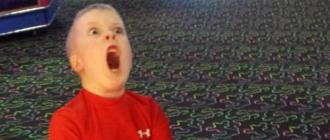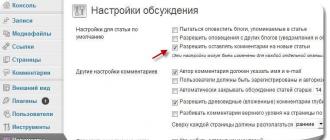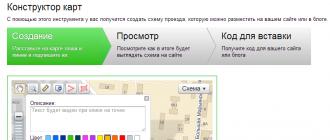I wanted to conduct an experiment with many participants to determine what is now more profitable for making money: “Yandex Advertising Network or Google Adsense?” I even wrote large and detailed instructions on how to do it simply and easily. Unfortunately, no one but me carried it out. Anyway.
Many wrote that they wanted to see the results, so I’m not publishing a mass experiment, but a single experiment with 6 sites =). For convenience, I created a visual summary table. The post is short, but I hope no less interesting for that.
Remember, I previously conducted 2 similar tests:
Today is part 3. It is good to carry out such tests once every year or two. Why? Firstly, the composition of advertisers is changing (some large ones may come or, conversely, leave a particular system). Secondly, the traffic on the sites is changing (today more people come to it for requests for one topic, after 6 months - for another). Thirdly, new formats are emerging, the income from which can surpass the competitor.
- Ad formats are roughly similar. For example, there is no Yandex advertising network (they were not included in the experiment).
- Same color scheme. Where it was possible to set the color scheme, it was set with identical settings.
- Rotation of ads. It is important to compare not over equal time periods, but in the process of rotation. Thus, the experiment is carried out on the same traffic.
- Number of clicks/impressions - from 200/20000. The more the better, but the period should be limited. Therefore, I do not recommend conducting tests on sites with low traffic (100-200 per day).
- The experiment involved only 1 ad unit on each site in the most clickable location.
Pivot table
What happened? I'm publishing the table.
Explanation:
- Adaptive "Netboard" - that's what I call it with the largest size for the netboard format;
- The old YAN code is the old Direct (which was before RTB, take the code);
- RTB Motion is a block of the Yandex Advertising Network for mobile devices. Relatively recently, it can be unscrewed perfectly on desktops (Netboard-type size, animation).
Who has won?

Surprisingly, YAN won in the 3rd part. I bet on Adsense to win. Does this mean that you need to remove all Adsense from the site and hang it with direct messages? Of course not:
- You may get completely different results on your sites. Before making a decision, it is necessary to conduct a similar experiment (link to instructions at the top of the post).
- If the systems showed the same earnings, then the advertisement must be placed in a consolidated manner - 50/50 (+ rotation of 2 different blocks in one place). For experimental subjects No. 3, 4 and as an option 6.
- If a specific service wins, then focus on it, but do not eliminate the competitor completely - 70/30. Subjects No. 1, 2 and 5.
- Don't forget about other unique formats, such as link blocks (although they are now ).
What is more profitable for you? Waiting for your comments !
Hi all! At the end of last year I announced an experiment. It's time to put it into practice. Subscribe to the topic so as not to miss anything interesting. If something is unclear, ask questions and we will figure it out.
1. What is required from a webmaster?
There is no need to show the site, give passwords or anything else.
Nothing special:
- Website running in YAN or Adsense. If it has not been added to some system, try adding it now.
- Resource attendance is from 300 unique visitors per day. You need to get at least 100 clicks per ad block. Less attendance will not allow this to be done (or there will be a long period of time).
- You will need to test 1 advertising location on one site. The more sites, the better. That is, minimal time will be spent organizing the test.
- At the end of the experiment, send me information on each experimental site: topic, format (blog, forum, etc.), data on CTR, eCPM, average cost per click, period, number of impressions, clicks (a table for entering data I I will provide).
2. Create ad rotation
First of all, we need the ads we test to be rotated. There are several options:
1. A simple ad rotator script.
There are many on the Internet (just an A/B test). I haven't tried everything. Test it.
2. For Wordpress - Ad Injection plugin
You can download the plugin here. It hasn't been updated for a long time, but WordPress works for me on the latest versions. After the experiment, you can simply remove it. You can read about the setup here. On the add ad codes tab, you can set the percentage of impressions. This will be the rotation. The plugin can also display advertisements in different parts of the page - you need to choose the usual place for the blocks.
There are other plugins too. If you find it, use it. The main thing is that the ads are rotated and receive the same number of impressions.
3. Service realbig.media
The service is here (free, there is a traffic limit, but I think no one will reach it). It is very convenient for experimentation - it allows you to quickly set up rotation.
- First you need to add a site.
- Then the block.
- We add ads for rotation to the block.
For complete convenience, you can provide access to adsense and YAN data to collect CPM (revenue per 1000 impressions). Attention: just in case, I disclaim responsibility - I do not vouch for the service and the confidentiality of the data to which you give access.

4. Any option of your choice
If you know other options for rotation, implement them. There is nothing fundamental in the previous paragraphs.
3. Place to place the rotator
It is highly advisable to choose the most clickable location. Most likely, you already have one. This is usually a block after a few paragraphs, after the content or after the heading.
4. What we rotate
The color scheme and design of advertisements should be as similar as possible. All blocks must be adaptive. If YAN uses a blue heading. then in Adsense it should be shown in blue. Of course, the blocks themselves will be different, but our task for the quality of the experiment is to increase the level of similarity
Which formats to compare. I suggest the following options:
1. For sites with less than 1000 unique visitors per day.
Here I recommend rotating 2 ads:
- adaptive (maximum netboard size - 580 by 400) google adsense (instructions for full adaptation here)
- YAN Motion block. It was conceived as a mobile unit, but now works well on desktops.
2. For sites with traffic above 1000 uniques per day.
Here I offer not 2 ads, but 4 (2 YAN and 2 Adsense):
- adaptive netboard;
- YAN Motion.
- old direct blocks (old codes can be found here). Adjust the size and number of advertisements to the size of the netboard.
- Google Adsense "Ads in article" (native).
Important : create blocks so that they can be easily found in statistics (titles, channels, etc.). Also note the dates of the experiment - do not take data on partial days.
5. When will the experiment be conducted and when will the results be recorded?
The experiment begins today (I am already collecting statistics) and will continue until the end of April. Of course, you can connect later (accordingly, your statistics will be collected later). Time limits are needed to motivate participation.
If you got here in May, it’s okay: create your own experiment, read what other participants did and share your results.
Each ad must receive at least 100 clicks or 10,000 impressions. A more accurate result will be shown by 300 clicks and 30,000 impressions. In general, the more, the better, but still within a limited time frame (otherwise, other factors may come into play).
6. What then?
Once you have achieved key indicators for clicks and/or impressions, write about it here, in private messages or by email ( [email protected]). I will send you a table that you will need to fill out (anonymized data on CPM, clicks, topics, and so on). After collecting data for most participants, I will consolidate and publish the data.
If you have any questions, ask!
Let's determine what is more profitable: Adsense or YAN!
I ran a test in which half of the visitors were shown AdSense ads, and the other half of the visitors were shown YAN ads.
Details, as well as a description of how to test and which ad units are more profitable, are in the article “”.
Initial data
Traffic patterns: search traffic is approximately 60/40 in favor of Google
Experiment result
During this time, $3.75 was earned from AdSense:
During the same period, YAN earned 473.71/62.5 = 7.58 $:

CPMV (cost of displaying one thousand blocks): 41.25 rubles.
conclusions
The Yandex Advertising Network turned out to be twice as profitable as AdSense. This result surprised me very much. Even if the income per thousand impressions of the AdSense block had not dropped by half, AdSense and YAN would have been equal in income - I did not expect such a result.
The tested AdSense block never dropped below $0.30 per thousand impressions throughout the entire period. Such a sharp drop in the relative size of the tested block seems very strange to me. If we assume that AdSense revenue comes only from visitors coming from the Google search engine, then this fits into the data obtained.
The explanation is as follows: previously, 50% of visitors came from Google and only they generated income. Now only half of these visitors were shown AdSense ads, so we get that visitors who were shown AdSense ads and who came from Google are 25% of the total number of visitors to the site. Hence the drop in income by exactly 2 times. To confirm this hypothesis or refute it as far-fetched, I am launching a new experiment: only AdSense advertising will be shown to visitors coming from the Google search engine, and only YAN advertising will be shown to visitors coming from the Yandex search engine. If the theory is correct, then the revenue per thousand impressions of the tested AdSense unit should not only return to its original value, but also increase significantly. Details and code for implementation in
Friends, today I want to tell you about my little experience in monetizing a website using contextual advertising from Yandex and Google. In the article you will find a description of earnings in the YAN and Adsense affiliate programs, as well as a comparison of the cost of clicks in these systems, based on personal experience.
Yandex advertising network andGoogleAdsense.
The Yandex Advertising Network (YAN) and Google Adsense are the names of affiliate programs of Internet search giants that allow webmasters to earn money on their sites. I think many readers have heard about these systems, or maybe they are already working successfully in them. For those who have not previously encountered contextual advertising, a few words below.
Search engines receive their main income from contextual advertising. Everyone has seen the following ads on the search results pages in Yandex and Google:

When competition among sites for a particular search query is high, sometimes it makes sense to simply buy interested visitors. Search engines sell visitors through contextual advertising. In the search results, a person is shown an ad that is relevant to his search query. If a person is interested in it and clicks on an advertising link, the advertiser pays the search engine a certain amount of money.
This works similarly for websites. Let's take a look at the site:

A contextual advertisement from Yandex is inserted above the article, upon clicking on which the advertiser pays the search engine a certain amount of money. How can a search engine motivate me to place their advertisement? Of course, a share of income. For both YAN and Adwords, this share is about 50%. Those. search engines take one half of the advertiser’s amount for a visitor’s transition from my site to his site, and give me the other half of the amount. As a result, everyone is happy: the advertiser received the target visitor, the search engine and I received money. It would seem: work and be happy, but the devil, as always, is in the details.
YAN or Adsense? Which system should you choose?
There are a lot of details and subtleties when working with contextual advertising. First of all, the question arises: which system to work with? This question leads to the so-called “holivar”. He is from the field: “Which is better: Windows or Linux?” Many webmasters work with both systems at once, which the latter, although they don’t really like, tolerate. But the question of which one brings more income always excites the minds of beginners. I will tell you about the features that should be considered when choosing.
- YAN has an attendance bar for admission to the system - 500 people per day within a month. Adsense accepts sites practically from scratch.
- Currently for work YAN requires conclusion of an agreement, which will include all your real data, and which will need to be sent to their office by mail (not electronic) or brought in person. This quest took place not long ago. Overall everything is good, but it takes a lot of time. With Adsense you can only get by scans of documents.
- Currently YAN will take from your earnings 13% personal income tax and pay them to the state for you (namely for you, not for yourself). For some this is a plus, for others it is a minus, and others do not have the right to engage in parallel activities due to their profession. This should be taken into account. Adsense offers webmasters on one's own resolve tax issues. At least for now.
- I’ve read a lot of stories about Adsense, when the webmaster’s account is blocked with the remaining funds and you can’t find the truth. I didn’t come across anything like this about YAN.
- The minimum amount for withdrawal from YAN is 3000 rubles, and for Adsense - 100$ , which until recently was almost equivalent, but is now significantly different.
- Both Adsense and YAN allow you to withdraw earned funds to Yandex.Money. With Adsense, to select a withdrawal method, you first need to accumulate at least 10$ .
- Block settings contextual advertising at YAN more flexible, but Adsense in some cases hides information that this is advertising, which has a positive effect on conversions.
- Adsense has a better click and conversion statistics system.
I made approximately these conclusions while working with these contextual advertising systems.
And now the most interesting thing - numbers.
I used YAN and Adsense on different sites of the same topic. Below is the average cost per click for 2014 by month:

What conclusions can be drawn from these numbers?
- Taking into account the current dollar exchange rate, working with Adsense has become twice as profitable as working with YAN.
- Most likely, such a difference in the cost of a click will be eliminated due to competition for advertisers between systems. Given that Yandex pays less, Google will be forced to reduce prices or lose customers. This is my personal opinion and is not necessarily true.
Conclusions: skim the cream off Adsense before it's too late. ;-)
P.S.: If you are on the other side of the barricades and, on the contrary, order advertising in Yandex.Direct or Adwords, then you probably know that this is not as simple as it might seem at first glance. To prevent money from going down the drain, you need to properly set up your advertising campaign, including retargeting. You can read more about what retargeting is and how best to set it up on the ADNOUS website, which is dedicated to this technology.
In contact with






